Rihanna’s infectious track “Work” took the world by storm, dominating charts and sparking countless dance interpretations across social media. If you’ve spent any time in the comments sections, you might have noticed a recurring debate: is Rihanna twerking, or is she “whining”? While both involve rhythmic hip movements, they are distinctly different dance styles, rooted in different cultural contexts. Let’s break down the nuances of the Whine Dance and set the record straight.
Many mistakenly label any hip-centric dance as “twerking,” but this overlooks the rich diversity of movement vocabulary, especially within Caribbean dance forms. The distinction between twerking and whining lies primarily in how the body moves, specifically the ass, hips, and waist.
Let’s first examine twerking. Think back to Rihanna’s provocative “Pour It Up” music video. This visual is a masterclass in twerking.
Drawing from West African dance traditions, specifically the mapouka from Cote d’Ivoire, twerking emphasizes isolated movements of the buttocks and hips. Mental Floss describes mapouka as the “dance of the behind,” noting its evolution from traditional forms to more expressive, contemporary versions.
“The movements involved in twerking show similarities to several traditional West African dances, most notably mapouka, hailing from the Cote d’Ivoire. Known colloquially as ‘la dance du fessier,’ or ‘dance of the behind,’ mapouka is said to exist in two forms: A tamer, more traditional dance performed ceremonially, and the newer, more scandalous version popular with young Ivoirians.” – Mental Floss
As seen in modern pop culture, particularly hip-hop and dancehall, twerking is characterized by vigorous, often rapid, shaking and thrusting of the buttocks. The focus is on making the ass move independently.
 Rihanna demonstrates twerking in her 'Pour It Up' music video, highlighting the hip and buttock movements characteristic of the dance.
Rihanna demonstrates twerking in her 'Pour It Up' music video, highlighting the hip and buttock movements characteristic of the dance.
Contrast this with the whine dance. Cast your mind back to Rihanna’s early hit, “Pon de Replay.” This track embodies the essence of whining.
Rooted in Caribbean culture, the whine dance is defined by a rhythmic rotation and thrusting of the pelvic girdle, as described by SpiceIslander, a Caribbean dance expert. It’s a core element of Soca music and dance.
“Whine is defined by a Caribbean dance expert as the thrusting or rotating of the pelvic girdle in a rhythmic pattern. … In the context of Caribbean culture, whine is a genuine regional dance form. … Unlike other genre of music that inspires the feet – such as “salsa’’, “kweyol’’ and “tango’’ – the dancing of soca music inspires the rhythmic movement of the waistline, more than any other body part.” – SpiceIslander
Whining is less about isolated buttock movement and more about fluid, graceful (or sometimes energetic) gyrations of the waist and pelvis. Think of it as a rhythmic, wave-like motion originating from the core. It can even incorporate body rolls and grinding movements, often done with a partner but also solo.
 Rihanna showcases the whine dance in her early hit 'Pon de Replay', emphasizing the fluid waist and pelvic gyrations that define this Caribbean dance style.
Rihanna showcases the whine dance in her early hit 'Pon de Replay', emphasizing the fluid waist and pelvic gyrations that define this Caribbean dance style.
In essence, twerking isolates the buttocks for shaking and thrusting, while the whine dance emphasizes a fluid, rhythmic movement of the waist and pelvis. Rihanna, being the dance chameleon she is, often blends both styles. You can see a combination of twerking and whining in the first part of the “Work” music video.
Mastering both twerking and the whine dance, and seamlessly integrating them? That’s next-level dance skill, putting you in the realm of dance icons like Rihanna herself. Understanding these distinctions not only enriches your dance vocabulary but also shows appreciation for the cultural roots of these dynamic movement styles.

